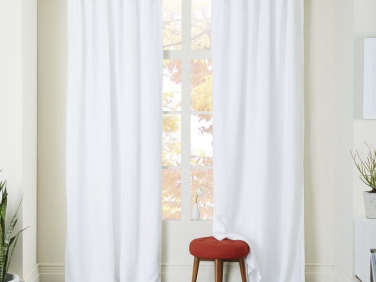This week we’re revisiting some of our favorite all-time summer stories, like this one:
Belgian linen is the champagne of linen: Of all the types of linen—already one of our favorite, and most timeless, materials—it’s a step above. But what makes Belgian linen so prized? And with such a wide range on the market, how can you tell whether what you’re buying is authentically Belgian?
We went to textile expert Zak Profera of Zak & Fox for some insight. “It is my favorite material to work with,” he says of linen. “I love it for its slubs and knots, the way it takes color, its natural sheen. There is a beauty in the variations—sometimes seen as ‘imperfections’, other times as ‘character’.”
Here’s a quick guide to this elevated/laid-back textile.

What is Belgian linen?
Linen is made from the fibers of the flax plant, and—according to Libeco Belgian Linen—it’s been prized for thousands of years for its softness, durability, and informality. The climate of western Europe (including France, Belgium, and the Netherlands) makes it ideal for growing flax. Belgium—and in particular, Flanders, the westernmost area of the country—has long been known for its linen production; though it’s called Belgian linen, the term refers to linen that is grown and woven entirely in Europe (not necessarily Belgium).
For much more on linen, see Object Lessons: Belgian Linen for Every Room.
What’s the difference between Belgian linen and Belgian flax linen?
While “Belgian linen” refers to a textile grown and made entirely in Belgium, from flax to finished product, “Belgian flax linen” (also called “European flax linen”) is made from European-grown flax imported and woven elsewhere, usually in India or China. There’s a difference in price, and proponents of pure Belgian linen say there is a difference in quality and durability.

Where is linen best used in interiors?
“At our new showroom, we use linen on everything from window treatments to upholstery, and everything in between,” Profera says. “We work a lot with a mix of materials, but linen dominates as the foundation for most of what we do.” Belgian linen gives a sophisticated but relaxed look just about anywhere, from the table to the bed to curtains and clothing.
Are there places where linen wouldn’t hold up well?
“Linen is a natural fiber, which means it can be temperamental based on the environment and its surroundings,” Profera says. “Humidity can make the fibers expand and contract, which means a 100 percent linen product used as drapery in a beach house isn’t the best choice if you’re finicky about your curtains remaining absolutely perfect. It also tends to hold its shape and has a memory for creases and wrinkles.” Embracing imperfection is part of the charm.

What are a few things to look for when buying Belgian linen?
To ensure what you’re buying is fully Belgian linen, look for a certificate of origin or a “Masters of Linen” seal on the tag, which signifies that the Masters of Linen Club, a European association, has kept an eye on the production and quality. (It means it’s eco-friendly too: Under the European Flax Charter, producers agree that the flax is farmed with zero irrigation, GMO, and waste.)
Beware of language like “woven from Belgian linen,” and be sure, too, that what you’re getting is 100 percent linen, not a linen weave with cotton and hemp woven in.
Note that, often, the European Flax Linen Association still keeps an eye on the quality of Belgian flax linen, so chances are you’ll still get a fairly quality product.

What can one expect to pay for quality Belgian linen?
You’ll pay more for authentic, certified Belgian linen. Barn & Willow’s curtains, for example, certified by the Masters of Linen Club, run from $199 to $790 per panel, whereas West Elm’s Belgian Flax Linen Curtains run from $99 to $149.
More expert advice on linen (and linens):
- Expert Advice: Tips for a Softly Moody Bedroom with London Stylist Twig Hutchinson
- Linen Logic: 20 Tips for Taking Care of Your Bedding
- Expert Advice: Proper Bed-Making 101, How to Make Square Corners, Step by Step
N.B.: This story originally appeared on June 8, 2018 and has been updated.
Frequently asked questions
What is Belgian linen?
Belgian linen is a type of linen fabric that is made from the flax plant and is produced in Belgium. It is known for its durability, strength, and softness.
What makes Belgian linen so special?
Belgian linen is known for its quality due to the climate, soil, and traditional weaving techniques used in Belgium. The flax plant is grown in the ideal damp and cool climate of the region, resulting in long and strong fibers that are then woven together using traditional methods to create a soft, luxurious linen fabric.
Is Belgian linen more expensive than other types of linen?
Yes, Belgian linen is often more expensive than other types of linen due to its high quality and reputation. However, it is considered a worthwhile investment due to its durability and longevity.
How do I care for Belgian linen?
Belgian linen should be washed in cold or lukewarm water and dried on a low heat setting. It should not be bleached or washed with harsh detergents. If the linen becomes wrinkled, it can be ironed on a low heat setting.
What types of items are typically made from Belgian linen?
Belgian linen is commonly used for bedding, table linens, and apparel such as dresses, shirts, and jackets. It can also be used for upholstery and drapery.





Have a Question or Comment About This Post?
Join the conversation